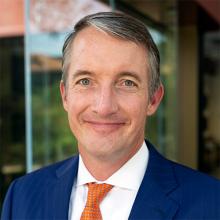
Inclusion and Equity


Centering Social Justice: NAFSA Resources to Advance Diversity, Equity, and Inclusion
NAFSA Diversity and Internationalization Summit
2021 Comprehensive The University of Texas at Austin
Located about 250 miles north of the U.S.-Mexico border, The University of Texas at Austin (UT Austin) is a comprehensive research institution that serves more than 50,000 undergraduate and graduate students. In 2016, the institution’s president expressed a renewed commitment to comprehensive campus internationalization. In 2019, UT Austin developed Texas Global, a centralized unit that coordinates global initiatives across campus. Through efforts to map global engagement and identify regions and partners of strategic interest, UT Austin has developed opportunities for student internships abroad, seed grants for faculty to pursue research with partners abroad, and virtual exchange and other curricular programming for students on the UT Austin campus.
On the first day of his new job as vice president for research at UT Austin in 2016, Dan Jaffe, PhD, met with his counterpart at the National Autonomous University of Mexico (Universidad Nacional Autónoma de México [UNAM]). They discussed which researchers at their respective institutions were collaborating, and Jaffe was unable to pinpoint with whom his faculty were working.
“At that point, we had really not put together the machinery for understanding even what our faculty were up to,” says Jaffe, who served as interim executive vice president and provost until mid-July. “And now, by gathering those threads together and building a strategy around certain people and target countries, we’re able to be much more effective with our [approach to internationalization].”
That same year, senior leadership at UT Austin announced a renewed commitment to global engagement and convened a task force charged with looking at models to strengthen internationalization at the large, highly decentralized research institution with approximately 80 academic departments across 18 schools and colleges. The task force identified the need to bring on a leader dedicated to championing international education.
Sonia Feigenbaum, PhD, senior vice provost for global engagement, was appointed UT Austin’s first chief international officer in 2018. “It became abundantly clear that there had been lots of activity but no mapping and no communication between the various parts of the university,” she says.
Since Feigenbaum came on board, comprehensive campus internationalization at UT Austin has involved taking a strategic and coordinated approach to global engagement. She wanted to bring together the various areas that contribute to the university’s global mission.
The result was the creation of Texas Global, which advances UT Austin’s global mission and includes a centralized division composed of Education Abroad, the English Language Center, Global Engagement and Strategy, Global Programs and Innovation, Global Risk and Safety, International Student and Scholar Services, and Special Initiatives.
“We’ve created programs that respond to the various aspects of internationalization where we’re advancing the mission of the university with research, with partnerships, with student and faculty mobility, and with global engagement on campus that is also informed by our visiting scholars, and a host of events and activities that take place on campus,” Feigenbaum says.
“All of these various units are contributing to the efforts of what is happening throughout the campus,” she adds. “Texas Global is the nucleus, and there are various spokes across the institution that allow us to advance the mission of internationalization.”
Texas Global used a mapping exercise to identify countries where the institution has numerous alumni or a large number of institutional, corporate, and nongovernmental organization (NGO) partnerships, Feigenbaum says. Working with other offices on campus such as the Business Contracts Office, the Office of Sponsored Projects, Texas Admissions, and Enrollment Management and Student Success, Texas Global developed a database that identifies faculty’s research and other international activities. Texas Global also has hired a dedicated director of global alumni relations to enhance engagement in key regions of the world.
Launching Experiential Learning Opportunities Abroad
In 2019, Texas Global created Global Career Launch, an initiative that leverages faculty connections at universities, research centers, companies, and nonprofit organizations around the world. Students can take part in partially funded internships and research abroad under the guidance of a UT professor and an international partner. This initiative advances internationalization, supports student mobility, and encourages faculty collaborations abroad, Feigenbaum says. Thirty students and five faculty members participated in the inaugural internships with partners in Brazil, Denmark, Israel, Mexico, and Thailand.
“Global Career Launch is designed to launch students into experiential learning opportunities that are career focused,” says Heather Thompson, director of education abroad.
Faculty receive seed grant funds, and students are awarded scholarships of up to $4,000 to help offset the cost of the internships, she says. The internship model varies depending on the program. In some cases, faculty travel with students to help them get settled, and then the students work with an in-country supervisor. In other cases, the professor remains abroad with the students the entire time. For summer 2021, Texas Global sent three cohorts of students abroad, and two other cohorts completed their internships virtually.
Kinesiology professor Hirofumi Tanaka, PhD, took students to Bangkok, Thailand, to complete a six-week internship in the exercise physiology laboratory at Chulalongkorn University. The students tested the physical fitness and performance of transgender adults and compared them with cisgender males and females. The internship offered an opportunity to inform policy as international bodies, such as the International Olympic Committee, have not yet issued final guidance on whether or not transgender athletes should be allowed to compete in women’s sporting events, Tanaka says.
Funding Interdisciplinary Projects
As part of UT Austin’s efforts to renew its focus on global engagement, former president Gregory Fenves, PhD, established the International Board of Advisors (IBA) in 2017. The group, composed of individuals representing multiple countries with connections to UT Austin, makes recommendations on how the university can expand its global network and enhance its presence around the world. David Wolcott, PhD, assistant vice provost for global engagement, says that the IBA was part of a much broader strategy to engage alumni in comprehensive internationalization efforts.
One of the board’s initial priorities was to increase experiential learning for UT students. This led to the development of a signature program, the President’s Award for Global Learning. The program provides seed funding for interdisciplinary, credit-bearing projects conducted by up to four students and three faculty members. “It brings together interdisciplinary teams of faculty and students to work on these projects abroad,” Wolcott says. “And it is a very rigorous proposal process where faculty teams must work with international partners to submit proposals that identify a topic that can be addressed in a global context.”
Since 2018, the program has supported 17 projects in 13 countries. The teams have included 48 undergraduate students, 19 graduate students, and 45 faculty members. For summer 2021, programs to Denmark, Jamaica, Jordan, and Mexico were allowed to run after a rigorous risk and safety approval process.
“This award [supports] faculty who go out and help deepen and strengthen our partnerships and find new ways to collaborate and really push the development of inquiry and leadership skills for our students,” says UT Austin President Jay C. Hartzell, PhD.
Tim Mercer, MD, director of the global health program at Dell Medical School, was the lead faculty on a team that received the award in 2018. He took a group of students to Puebla, Mexico, to conduct a community health needs assessment. “It really helped galvanize our partnership with our partners there in Mexico,” he says. “Working together on this project really laid the groundwork for our global health partnership going forward, so it was tremendously catalytic in that sense.”
“I was able to learn a lot of skills that have followed me into the clinic,” says Veronica Remmert, a current medical student who participated in the program as an undergraduate at UT Austin. “The project has greatly impacted the way that I view patient encounters and how I seek to be as a physician.”
Meeting Community Needs Through Service Learning
Another interdisciplinary program is Projects with Underserved Communities (PUC), which the university has run since 2009. The program consists of a three-course sequence that pairs social work and engineering students with NGOs abroad. In the fall, the students work with their NGO partner on a community needs assessment and examine the feasibility of different projects. They also fundraise to cover the cost of implementation. Over the course of the year, the teams design their projects in collaboration with the community and the NGO, says Kirsten Hagen, MA, program coordinator. The student teams also present their projects to a service learning advisory board composed of representatives from UT Austin and industry leaders in fields such as engineering, social work, international education, and regional planning.
“There is a really strong focus on community-based development and building those partnerships with communities,” Hagen says. “Both the community and the students are contributing, and they’re both benefiting from the project.”
Nina Lobo, a civil engineering major who graduated from UT Austin in 2017, worked on a project constructing a learning and resource center for a community in south India. It allowed different religious groups in the community to come together in a neutral space to take classes, access the internet, and learn English. “We wanted them to have a kind of a space where they could get together on a more level playing field,” she says.
Since then, Lobo has helped create a PUC alumni group that advises current students on their projects. She says that participating in the program was a turning point in her engineering studies at UT Austin. “I think the whole time that I was at UT, I had been searching for a way to connect my degree back to social impact,” says Lobo, who now works at a nonprofit focused on equitable access to solar power. “And the PUC program was one of the first times that I found an ability to do that and really take ownership of a project from start to finish that really affected and reached people.”
Planting The Seeds For Sustainable Research
Another effort to encourage faculty to conduct global research is a competitive $10,000 seed grant program. “Funded by Texas Global, the program was initiated in November 2020 and provides financial support to faculty in order to develop and strengthen new or existing partnerships with global universities or organizations,” Wolcott says.
The first round of funding went to nine proposals involving 11 UT Austin faculty who are collaborating with 10 partners in Australia, Chile, Egypt, France, Israel, Pakistan, Portugal, South Africa, and Spain. Topics include urban housing in Egypt (in collaboration with the American University of Cairo) and the future of work in the age of the pandemic (with partners at the University of Cape Town). The second round of funding went to eight proposals involving 11 UT Austin faculty who are collaborating with nine partners in Ecuador, England, Germany, Mexico, Portugal, Scotland, and South Korea. Topics include next-generation tropical ecology (in collaboration with Universidad San Francisco de Quito) and developing smart energy neighborhoods (with partners at Seoul National University).
Wolcott says that while the goal is to facilitate peer-to peer collaboration, UT Austin will also look at possible institutional partnerships if there are multiple faculty members working together.
Speech pathology professor Stephanie Grasso, PhD, received one of the seed grants for her research on bilingual individuals who present with primary progressive aphasia, a form of dementia that affects speech and language. “There’s a growing body of evidence showing that speech language intervention coming from the field of speech language pathology can actually benefit specific communication skills and even slow the progression of the loss of communication abilities,” she says.
The challenge is that the majority of research in this area has focused on monolingual, English-speaking participants. “Very little is known about how bilingual speakers respond to these types of tailored intervention approaches,” Grasso says. Grasso is collaborating with researchers at the Sant Pau Biomedical Research Institute, a research consortium under the leadership of Sant Pau Hospital and affiliated with the Autonomous University of Barcelona in Spain. The team is examining the effects of a tailored speech and language teletherapy program that is being administered to bilingual individuals who speak Spanish and Catalan.
The seed grant funds the work of a staff member at Sant Pau who is administering the therapy in Catalan, Grasso says. Wolcott says that one of the goals of the seed grant funding is to help faculty collect preliminary data that will allow them to apply for larger grants.
Promoting Entrepreneurship Around The World
Texas Global oversees the Global Innovation Lab (GIL), which is focused on entrepreneurship and helping international companies launch products across the globe. “We train entrepreneurs on how to effectively assess target markets, build their company infrastructure, and plan commercialization strategies for global market entry. We also assist them with access to prospective customers, partners, and sources of capital,” says Glenn Robinson, MA, GIL assistant director.
The team primarily works with entrepreneurs who are testing their prototypes. In addition, Robinson and his colleagues have helped establish incubator networks in India and other countries and technology transfer processes that help entrepreneurs deal with issues such as intellectual property rights.
While their work has historically dealt with technology, they have started focusing more on social enterprise innovations in countries like Bhutan, Chile, and Colombia. As a result, GIL has launched an initiative focused on women entrepreneurs in emerging markets.
Robinson says that GIL builds awareness of UT Austin’s academic programs in order to recruit talented international students to the institution. In addition, GIL has taken a group of female students from UT Austin to meet their counterparts at the Indian Institutes of Technology to share their experiences as future entrepreneurs.
Engaging Alumni Through Texas Global Dialogues
Prior to the pandemic, Texas Global launched several initiatives to engage international alumni, including hosting events abroad. But after March 2020, the unit had to rethink how it approached international alumni programming. “Rather than being able to bring live events to alumni, we switched to a virtual mode,” says Thuy Nguyen, MA, global strategies officer.
One of the initiatives Texas Global launched in partnership with Texas Exes, UT Austin’s nonprofit alumni association, was Texas Global Dialogues, which brought together panels of faculty and alumni to discuss the latest trends in certain fields and regions. The first event, held in August 2020, focused on journalism in Latin America. Subsequent dialogues revolved around sustainable energy and artificial intelligence.
Lisa Anaya, MA, global strategies officer, says that virtual programming has helped expand UT Austin’s international alumni outreach. “We’re making all of these inroads with alumni that we would have never been able to see or speak to before,” she says. In the future, the institution can use those connections to invite alumni to regional events.
Creating A Sustained Physical Presence Around The World
President Hartzell says that an expanded physical presence in key locations is the next step in UT’s internationalization efforts.
UT Austin’s ongoing engagement with Mexico has led to the establishment of a physical presence there. In 2017, the institution opened its first Global Gateway office at UNAM in Mexico City, which will serve as a focal point for UT Austin’s activities in Mexico. While some efforts were delayed due to the pandemic, Texas Global is currently recruiting to fill the director position.
Jaffe says that the office is the first of several Global Gateways that UT Austin will open over the next few years—a direct result of the mapping and data collection exercises that Texas Global recently completed.
“Opening these Global Gateways within the major regions of the world is going to be really important to us so that our alumni, our faculty partners, and our corporate partners in those regions feel that we are a sustained presence,” Wolcott says.
Cross-Campus Collaborations to Enhance Diversity, Belonging, Inclusion, and Equity (DBIE) Work
Achieving Affordable and Equitable Participation in Education Abroad
Successful International Student Peer Mentoring: Demonstrating #YouAreWelcomeHere in Onboarding and Orientation Programming








